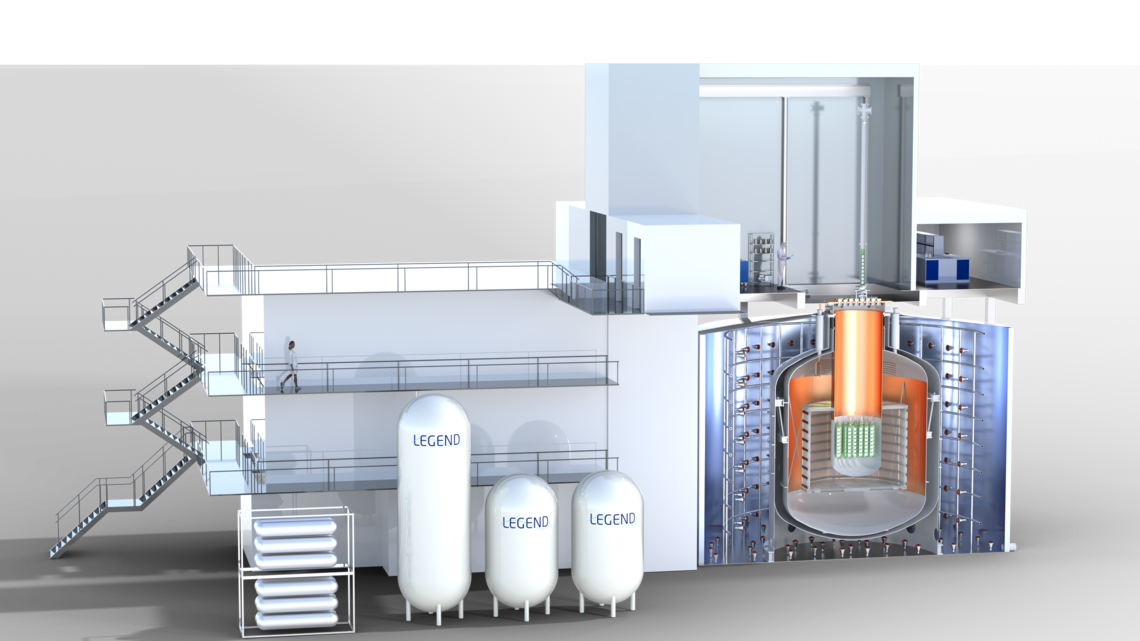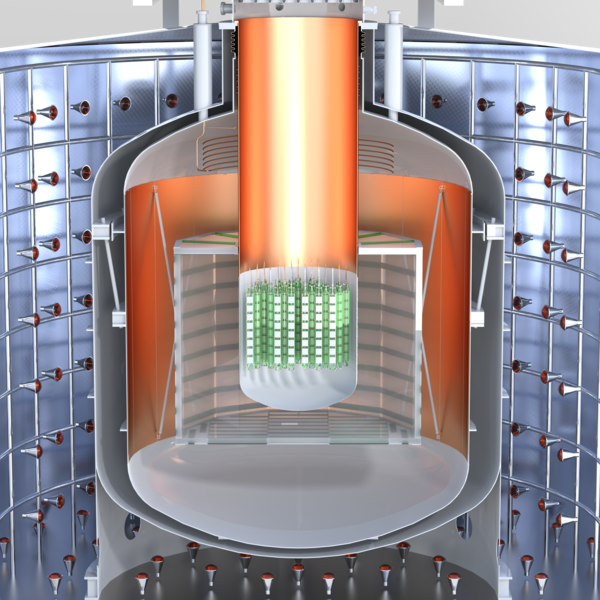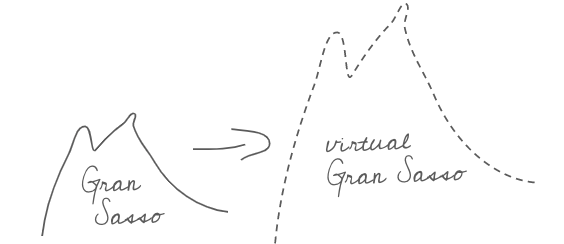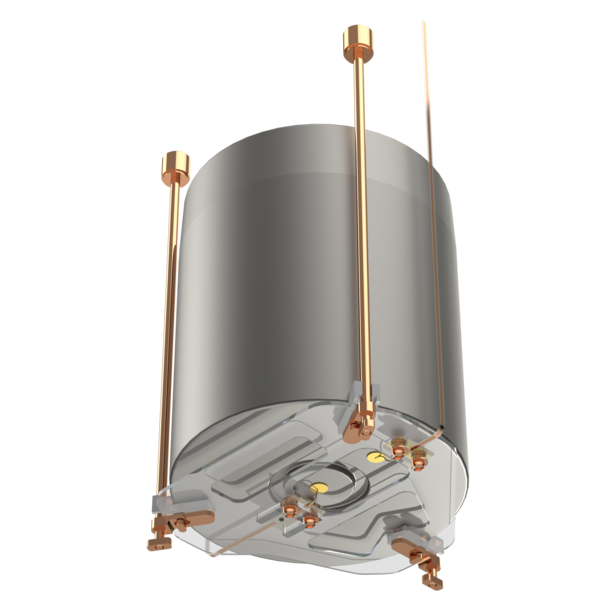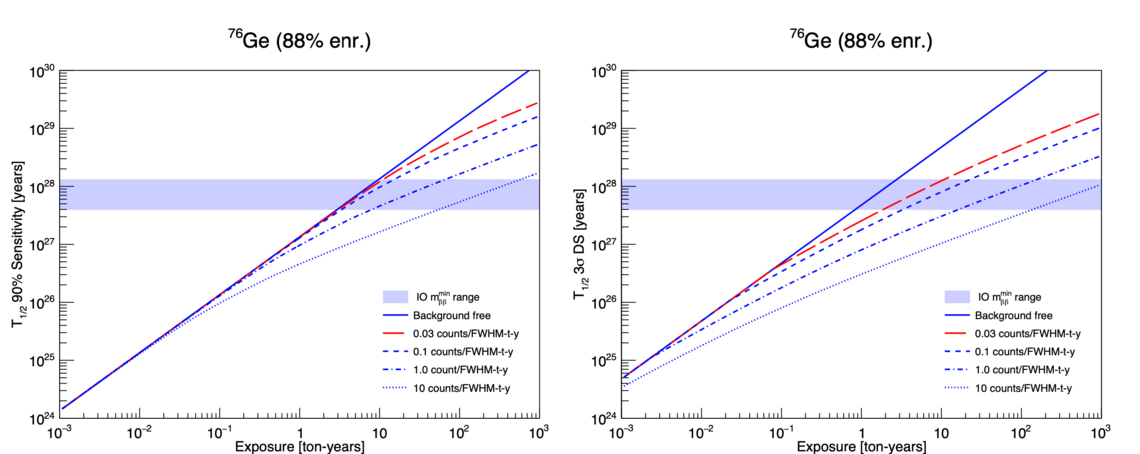LEGEND 1000
Second Stage
Goals & Sensitivity
If an experiment’s background is zero both the discovery sensitivity as well as the limit sensitivity scale linearly with the exposure, while in the background-dominated regime both sensitivities scale with the square root. LEGEND’s staged approach provides a low-risk path to world-leading sensitivity.
LEGEND’s ultimate goal is to achieve 3-σ discovery sensitivity covering the full parameter space remaining for the inverted neutrino mass ordering, under the assumption of light left-handed neutrino exchange as the dominant mechanism. LEGEND-1000 upgraded detector infrastructure should achieve strong further background rejection. The background goal for LEGEND-1000 is < 10-5 cts/(keV·kg·yr) or < 0.03 cts/(FWHM·t·yr). With this background level, LEGEND-1000 will reach a discovery sensitivity of 1028 yr. , corresponding to a mββ < 10-20 meV.
► Baseline design
The LEGEND-1000 technical design is currently prepared for an experimental site at LNGS and SNOLAB. It is centered around the demonstrated low-background and excellent energy performance of p-type, point-contact (PPC) high-purity Ge (HPGe) semiconductor detectors, enriched to over 90% in 76Ge. The larger mass inverted-coaxial, point contact (ICPC) detectors will be the standard in use for LEGEND-1000. When combined with the LEGEND-200 ICPCs, under 400 individual ICPCs with an average mass of 2.6 kg will be instrumented for a total detector active mass of 1000 kg. The detectors are mounted using underground electroformed Cu (UGEFCu) rods that provide physical support and electrical isolation through plastic insulators.
The background rejection power of ICPC-style detectors begins with their superior energy resolution, demonstrated to be as low as 0.12% FWHM at Qββ, which is sufficient to separate 2νββ from 0νββ decays. Beyond the tight energy cut, additional cuts based on pulse-shape analysis parameters offer a discrimination of backgrounds from the 0νββ signal of interest. A pulse shape analysis of the charge-collection signature from a bulk energy deposition can be distinguished from a multiple-interacting ray and surface events. The highly granular nature of the Ge detector array allows discrimination of background interactions that span multiple detectors. Finally, background interactions external to the Ge detectors are signaled by an active liquid Ar (LAr) shield.
The Ge detectors will be split among single strings of 8 detectors each. The strings, will be immersed within the LAr active shield, sourced from radiopure underground Ar, to provide direct mitigation of background. The LAr scintillation light will be readout by a curtain of wavelength-shifting (WLS) polystyrene fibers. The TPB (tetraphenyl butadiene) coated fibers are coupled to silicon photomultiplier (SiPM) photodetectors at each end and read out by charge-sensitive amplifiers. The underground LAr (UGLAr) volume will be surrounded by atmoshperic LAr, with additional light collection and neutron absorber, and supported within a vacuum-insulated cryostat, itself inside a water tank providing infrastructure and additional shielding.
► Background considerations
LEGEND-1000 represents a factor of 100 reduction over what has previously been achieved in GERDA, the lowest background 0νββ experiment to date. The successes of GERDA and the MAJORANA-DEMONSTRATOR lay the foundation for construction of a ton-scale experiment capable of meeting this ambitious goal. We have estimated the expected background rate through a comprehensive Monte Carlo simulation campaign, relying on the extensive radiopurity assays of selected materials, proven active background suppression through a liquid-argon Compton veto and the pulse-shape discrimination capabilities of PPC germanium detectors, and opportunities afforded by new capabilities such as argon sourced from underground and new readout electronics development.
- From radioassays, the expected contributions from the 238U and 232Th chains to the LEGEND-1000 background rate are (2.9 ± 0.6) · 10-6 counts/(keV kg yr) and (1.6 ± 1) · 10-7 counts/(keV kg yr), respectively.
- Conservative estimations set the background contribution from 42Ar present in Argon from underground extraction to be (4.4 ± 2.5) · 10-7 counts/(keV kg yr).
- Cosmogenic isotopes 68Ge and 60Co produced by exposure of germanium to cosmic ray neutrons, and decay within enriched detectors. They are effectively removed in the enrichment production process from the initial feed stock, and the zone-refinement of the material to produce semiconductor-grade germanium again removes any produced 60Co. Carefully controlling the exposure of the material to cosmic rays through underground storage and expedited transport over ground in shielded containers, the backgrounds from these cosmogenics can be managed.
- Decays of α-emitting isotopes on the surfaces of detectors are difficult to quantify a priori, as they are dependent upon a surface contamination mechanism that is not well understood. The Ge detectors are only sensitive to αs impacting the limited passivated surfaces forming the insulating boundary between n+ and p+ contact surfaces (n+ surfaces are too thick for αs to penetrate, and p+ surfaces yield full-energy α depositions outside of the 0νββ ROI). Pulse shape discrimination is highly effective at removing α events on these passivated surfaces. A background index upper-limit based on α event rates measured in GERDA and the expected PSD rejection capability has been estimated at < 7.2 · 10-7 counts/(keV kg yr).
Finally, while prompt backgrounds from ground-penetrating cosmic ray muons are readily vetoed, delayed backgrounds resulting from the production of cosmogenic isotopes that decay out of coincidence with the primary muon (most notably 77Ge and 77mGe), are more difficult to reject. The expected production of these isotopes has been simulated, and the background index from these delayed muon-induced backgrounds estimated at (6 ± 12) · 10-8 counts/(keV kg yr) at SNOLAB or (4 ± 3) · 10-7 counts/(keV kg yr) at LNGS.
Performance and physics parameters
LEGEND-1000 discovery potential and background projections.
Parameter | Value |
|---|---|
Performance Parameters | |
| 0νββ Isotope | 76Ge |
| Enrichment fraction | 92% |
| Isotopic mass | 910 kg |
| Qββ | 2039 keV |
| Energy resolution at Qββ | 2.5 keV FWHM |
| Overall analysis efficiency | 0.70 |
| Run time | 10 yr |
| Background goal | < 0.03 cts/(FWHM·t·yr) |
| < 10-5 cts/(keV·kg·yr) | |
| τ½0ν | 1.4 · 1028 yr (90% C.L. Sensitivity) |
| 1.2 · 1028 yr (3-σ Discovery) | |
| mββ | 10 – 20 meV (3-σ Discovery) |
| 9 – 19 meV (90% C.L. Sensitivity) | |
Physics Parameters | |
| M0ν | 2.81 – 6.13 |
| G0ν | 2.36 ·1015 /yr - 2.37 · 1015 /yr |
| gA | 1.27 |
Sensitivity study
The sensitivity to a 0νββ decay signal as a function of exposure and background separately for a 3-σ discovery and a 90% C.L. upper limit analysis. The calculation assumes a total signal efficiency of 60%, accounting for the enrichment level, the PSD signal survival probability, the active volume fraction, and the containment efficiency for neutrinoless double-beta decay events to have their full energy deposited within a crystal’s active volume.

